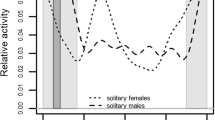Abstract
Animals often show a strong antipredatory response when they are exposed to their most deadly predator. In northern vole populations, the least weasel, Mustela nivalis nivalis, is probably the most important predator of voles. Because of its small size and slender body shape, the least weasel is capable of hunting voles in their burrows. However, small voles can potentially escape weasel predation by selecting holes smaller than those weasels can enter. We studied the choice of nest holes and refuges by two species of voles under simulated predation risk. In a laboratory experiment, voles were provided with four nest boxes as refuges, with individually adjusted entrance sizes. When exposed to the odour of a weasel, voles did not choose the smallest opening; they rather seemed to trade full protection for easy and immediate access by choosing the nest box with an intermediate entrance size. When outside the nest at the time when a weasel entered the arena, voles avoided the refuges with the smallest holes. In addition to using refuges on ground level, voles climbed on top of the boxes as an escape reaction, as well as exhibiting a variety of behavioural responses, such as fast running, freezing and sneaking.




Similar content being viewed by others
References
Boonstra R, Krebs CJ (1979) Viability of large and small-sized adults in fluctuating vole populations. Ecology 60:567–573
Chitty D (1952) Mortality among voles (Microtus agrestis) at Lake Vyrnwy, Montgomeryshire in 1936–9. Philos Trans R Soc Lond B 36:505–552
Cooper WE Jr (1997) Escape by a refuging prey, broad-headed skink (Eumeces laticeps). Can J Zool 75:943–947
Cooper WE Jr (2003) Risk factors affecting escape behavior by the desert iguana, Dipsosaurus dorsalis: speed and directness of predator approach, degree of cover, direction of turning by a predator, and temperature. Can J Zool 81:979–984
Cooper WE Jr, Dyk JH van, Mouton PLFN (1999) Incompletely protective refuges: selection and associated defences by a lizard, Cordylus cordylus (Squamata: Corylidae). Ethology 105:687–700
Dill LM, Houtman R (1989) The influence of distance to refuge on flight initiation distancein the gray squirrel (Sciurus carolinensis). Can J Zool 67:233–235
Erlinge S (1975) Feeding habits of the weasel Mustela nivalis in relation to prey abundance. Oikos 26:378–384
Halle S, Stenseth NC (1994) Microtine ultradian rhythm of activity: an evaluation of different hypotheses and triggering mechanisms. Mammal Rev 24: 17–39
Hanski I, Henttonen H, Korpimäki E, Oksanen L, Turchin P (2001) Small rodent dynamics and predation. Ecology 82:1505–1520
Hansson L, Henttonen H (1985) Gradients in density variations of small rodents: the importance of latitude and snow cover. Oecologia 67:394–402
Henttonen H, Oksanen T, Jortikka A, Haukisalmi V (1987) How much do weasels shape microtine cycles in the northern Fennoscandian taiga? Oikos 50:353–365
Jedrzejewska B, Jedrzejewski W (1990) Antipredatory behaviour of bank voles and prey choice of weasels—enclosure experiment. Ann Zool Fenn 27:321–328
Jedrzejewski W, Jedrzejewska B, McNeish E (1992) Hunting success of the weasel Mustela nivalis and escape tactics of forest rodents in Bialowieza National Park. Acta Theriol 37:319–328
Jedrzejewski W, Rychlik L, Jedrzejewska B (1993) Responses of bank voles to odours of seven species of predators: experimental data and their relevance to natural predator vole relationships. Oikos 68:251–257
Kramer DL, Bonenfant M (1997) Direction of predator approach and the decision to flee to a refuge. Anim Behav 54:289–295
Krivan V (1998) Effects of optimal antipredator behavior of prey on predator-prey dynamics: the role of the refuges. Theor Popul Biol 53:131–142
Lima SL, Dill LM (1990) Behavioral decisions made under the risk of predation: a review and prospectus. Can J Zool 68:619–640
Martín J, López P (2000) Costs of refuge use affect escape decisions of Iberian rock lizards Lacerta monticola. Ethology 106:483–492
McPhee ME (2003) Generations in captivity increases behavioral variance: considerations for captive breeding and reintroduction programs. Biol Conserv 115:71–77
Milne T, Bull MC (2000) Burrow choice by individuals of different sizes in the endangered pygmy tongue lizard Tiliqua adelainensis. Biol Conserv 95:295–301
Norrdahl K, Korpimäki E (1995) Mortality factors in a cyclic vole population. Proc R Soc Lond B 261:49–53
Simms DA (1979) North American weasels: resource utilization and distribution. Can J Zool 57:504–520
Sokal RR, Rohlf FJ (1997) Biometry: the principles and practice of statistics in biological research, 3rd edn. Freeman, New York
Sundell J, Norrdahl K (2002) Body size-dependent refuges in voles: an alternative explanation of the Chitty effect. Ann Zool Fenn 39:325–333
Venzon M, Janssen A, Pallini A, Sabelis MW (2000) Diet of a polyphagous arthropod predator affects refuge seeking of its thrips prey. Anim Behav 60:369–375
Ylönen H (1988) Diel activity and demography in an enclosed population of the vole Clethrionomys glareolus (Schreb.). Ann Zool Fenn 25:221–228
Ylönen H (2001) Predator odours and behavioural responses of rodents: an evolutionary perspective. In: Pelz H-J, Cowan DP, Feare CJ (eds) Advances in vertebrate management 2. Filander, Furth, pp 123–138
Ylönen H, Pech R, Davis S (2003) Heterogeneous landscapes and the role of refuge on the population dynamics of a specialist predator and its prey. Evol Ecol 17:349–369
Acknowledgements
We are grateful to the staff of the Konnevesi Research Station of the University of Jyväskylä for constructing the experimental arenas and providing the facilities, and to D. Dudek, M. Haapakoski and E. Rantanen for their assistance in conducting the experiments. This study was funded by the Academy of Finland (project nos. 44887 and 44878; Finnish Centre of Excellence Programme 2000–2005). Burt P. Kotler, K. Norrdahl and J.O. Wolff are acknowledged for their comments on an earlier version of the manuscript. The experiments were conducted with the permission of the Committee of Animal Experiments, University of Helsinki (licence no. HY368) and the Ministry of the Environment, Finland (licence no. 10/5713/2001).
Author information
Authors and Affiliations
Corresponding author
Additional information
Communicated by P.A. Bednekoff
Rights and permissions
About this article
Cite this article
Sundell, J., Ylönen, H. Behaviour and choice of refuge by voles under predation risk. Behav Ecol Sociobiol 56, 263–269 (2004). https://doi.org/10.1007/s00265-004-0777-6
Received:
Revised:
Accepted:
Published:
Issue Date:
DOI: https://doi.org/10.1007/s00265-004-0777-6




